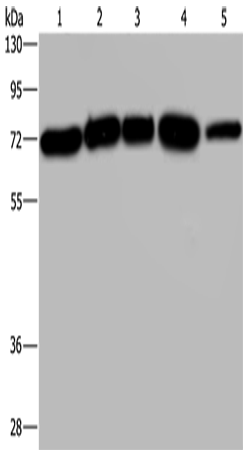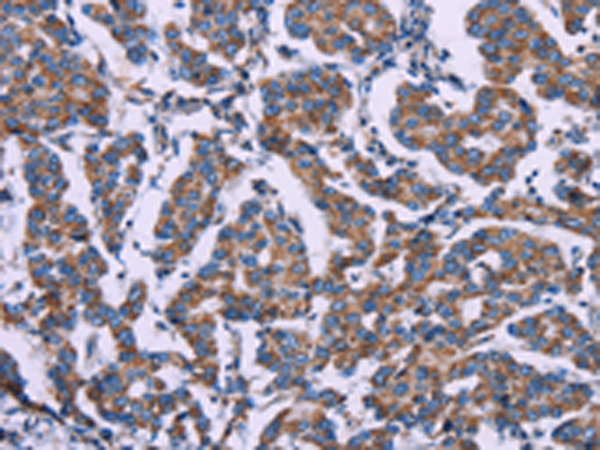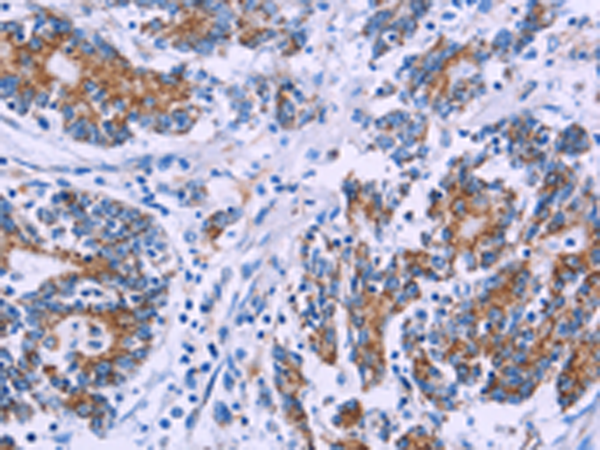


| WB | 咨询技术 | Human,Mouse,Rat |
| IF | 咨询技术 | Human,Mouse,Rat |
| IHC | 1/50-1/200 | Human,Mouse,Rat |
| ICC | 技术咨询 | Human,Mouse,Rat |
| FCM | 咨询技术 | Human,Mouse,Rat |
| Elisa | 1/2000-1/5000 | Human,Mouse,Rat |
| Aliases | HRB; RAB; RIP |
| WB Predicted band size | 58 kDa |
| Host/Isotype | Rabbit IgG |
| Antibody Type | Primary antibody |
| Storage | Store at 4°C short term. Aliquot and store at -20°C long term. Avoid freeze/thaw cycles. |
| Species Reactivity | Human, Mouse, Rat |
| Immunogen | Fusion protein of human AGFG1 |
| Formulation | Purified antibody in PBS with 0.05% sodium azide and 50% glycerol. |
+ +
以下是关于AGFG1抗体的3篇文献示例(信息基于公开研究整理,仅供参考):
---
1. **文献名称**:*AGFG1 promotes HIV-1 assembly by interacting with viral nucleocapsid protein and host components*
**作者**:Zhou, X., et al.
**摘要**:该研究利用AGFG1抗体进行免疫共沉淀实验,揭示AGFG1通过与HIV-1核衣壳蛋白及宿主ESCRT复合物互作,调控病毒颗粒组装和释放的分子机制。
---
2. **文献名称**:*AGFG1 modulates EGFR recycling and tumor progression in glioblastoma*
**作者**:Wang, Y., et al.
**摘要**:通过AGFG1抗体的免疫组化和Western blot分析,发现AGFG1通过影响EGFR内吞循环通路促进胶质母细胞瘤的侵袭性生长,提示其作为潜在治疗靶点。
---
3. **文献名称**:*Proteomic analysis of AGFG1 interactions reveals its role in mRNA nuclear export*
**作者**:Lee, S., et al.
**摘要**:研究使用AGFG1抗体进行质谱联用实验,鉴定出AGFG1与核孔蛋白及RNA结合蛋白的相互作用,证实其参与mRNA出核转运过程,影响基因表达调控。
---
(注:若需获取具体文献,建议通过PubMed或期刊数据库查询近年发表的AGFG1相关研究。)
The AGFG1 antibody is a research tool designed to detect ArfGAP with FG repeats 1 (AGFG1), a protein involved in intracellular trafficking and RNA metabolism. AGFG1. also known as HRB or RAB, functions as a cofactor in nuclear export of unspliced viral RNAs, particularly in HIV-1 replication, by interacting with the viral Rev protein and the CRM1 export machinery. It contains an ArfGAP domain and FG repeats, enabling roles in vesicle formation, nucleocytoplasmic transport, and mRNA processing.
AGFG1 antibodies are commonly used in techniques like Western blotting, immunoprecipitation, and immunofluorescence to study AGFG1’s expression, localization, and interactions in cellular models. These antibodies aid in exploring AGFG1’s contributions to viral pathogenesis, cancer progression (e.g., leukemia, breast cancer), and neurological disorders, as dysregulation of AGFG1 is linked to altered RNA transport and signaling pathways.
Most AGFG1 antibodies are raised in hosts like rabbits or mice, targeting specific epitopes (e.g., N-terminal or C-terminal regions). Validation includes testing on knockout cell lines or tissues to ensure specificity. Commercial antibodies often provide data across human, mouse, and rat samples. Research utilizing AGFG1 antibodies continues to clarify its dual roles in viral replication and cellular homeostasis, highlighting its potential as a therapeutic target.
×